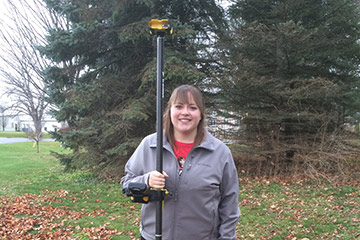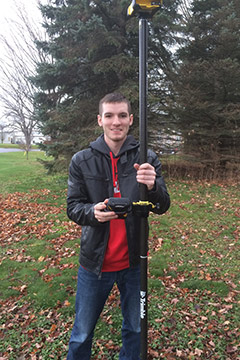Future Geographers Volunteer for Village Project

12/15/2015
Volunteering is a win-win situation.
Take the Village of McGraw, N.Y., which now can efficiently manage any needed repairs or upgrades to its new $3 million public water distribution system, thanks to the diligent and trained efforts of two SUNY Cortland seniors.
After buying and installing the new water system to replace its 100- to 150-year-old metal pipes with plastic PVC ones, the village hadn’t money left over to track its residential water route for the sake of any future maintenance work.
But Nicholas Goffredo, a geographic information systems (GIS) major from Catskill, N.Y., who graduates next spring, and Mary Colomaio of Bath, N.Y., another GIS major who finishes this December, gave up significant personal time to do the work anyway.
 |
|
| Nicholas Goffredo |
Some internships involve paid work for the students but in this case Goffredo and Colomaio eagerly sought the additional experience without pay.
The Geography Department’s service interns, for their part, have gained additional experience with cutting-edge electronic mapping technology on the cusp of using it in their future workplaces.
“This allows us to get our hands dirty as much as possible,” Colomaio said. “We are constantly given opportunities for internships at the College and outside the College. It strengthens our bonds out in the community and gives us an opportunity to give back in a way that other departments might not have.
“You want to do it because it’s just work that has to be done,” Colomaio said. “It’s hard for some of the smaller communities to afford.”
One benefit, they said, was they were able to borrow and practice using the City of Cortland’s very sophisticated computer mapping software equipment.
Richard Nauseef, a SUNY Cortland facilities plant engineer who happens to be McGraw’s deputy mayor, made sure before the interns arrived for work that test boxes, inline valves, fire hydrants, hydrant valves, curb stops, and residential shut-off valves were correctly flagged with electronic markers that can be detected by hand-held readers.
“It’s something we really needed to do,” Nauseef said of McGraw’s water distribution project. “This was a seven-year project. Seven years ago, we weren’t thinking about GIS mapping for this, but we were by the time we got done. If the location of something gets lost, without the information you’re digging and poking and hoping you can find it.”
The students inputted the information that can be used to produce a map that village employees can take into the field even if they don’t have with them or don’t know how to use GIS software.
“It’s pretty important because in the winter, when pipes are frozen, the village can more quickly find a turnoff valve to shut the water off, potentially preventing more damage,” Goffredo said. “My work could be the difference between knowing where the shut-off valve is within two feet or within 10 to 15 feet. That can make a big difference when you’re digging around in the snow looking for the leak.”
“I’m just totally impressed and very appreciative that they gave their personal time to do this project,” Nauseef said. “We couldn’t have afforded to hire someone to do this. It was a critical upgrade for our village. Now it doesn’t matter if it’s in 20 years, 50 years or 100 years, we will be able to find these spots as a result of this project.”
“It’s nice to get pay or college credit to do something like that, but in doing volunteer work it allows me to purely focus on the work aspect of it,” Goffredo said. “I can focus on how people go about doing the work, solving the problem. The village could not afford the work and so it was nice to be able to give that to them.”
Students from the department provided more than 600 hours of internship service this academic year, said Geography Department chair David Miller, SUNY distinguished teaching professor of geography.
“Our department has a long history of walking the talk,” Miller said.
The department this semester also has had three students working with the Town of Dryden Water Department and another two with the Cortland Water Department, he noted.
Adam Levine, SUNY Cortland’s facilities and geographic information systems manager, has arranged some of these geographic database town-gown projects.
“For a town like this, it’s just invaluable,” Levine said. “McGraw has absolutely no GIS program, and what happens is over the years the maps deteriorate and technicians who have 30 years of experience, who have it all in their head, retire or leave. Then there’s project construction including residential driveway paving where the water shut-off valves get covered. Having the information in a system that can be updated and an accurate map is important.”
Neither Goffredo nor Colomaio are new to service internships, although some of them were paid.
In fall 2014, the same pair teamed up to mark trails and historic trees at Camp Huntington of the William H. Parks Family Center for Environmental and Outdoor Education under the direction of Biological Sciences Department professor and chair Steven Broyles.
Last spring, Goffredo helped the City of Cortland’s Department of Public Works track the most efficient garbage pickup route using GIS technology.
For the last year and a half before the project in McGraw, Colomaio worked for the College on mapping the major points along its project to replace and upgrade the main campus electrical system. Currently, she’s logging data on another water system project for the small Village of Dryden, N.Y., borrowing the GPS equipment from one of her professors to do the job.
“In both of these projects I’ve kind of become the lead in this, coordinating it to make sure the project is getting finished, the work is getting done,” Colomaio said.
“A lot of the opportunities I’ve been given have come from the relationships of professors with the College and the community,” she said. “I’m getting extremely realistic, real world experience. Some students don’t get the chance to apply what they learn directly. I graduate in two weeks and I’m comfortable with what I’ve been learning. I know this is what I want to do for the rest of my life.”

